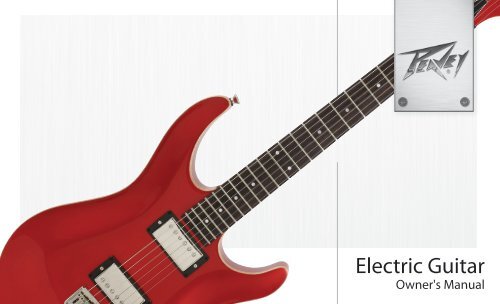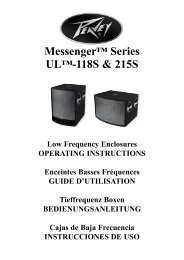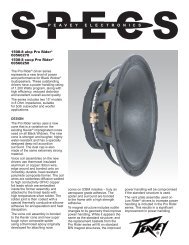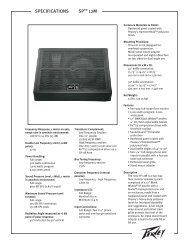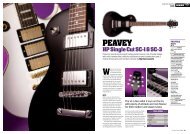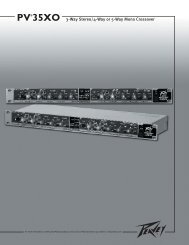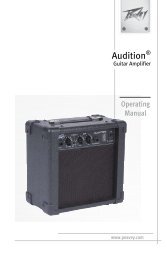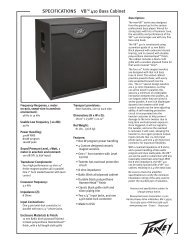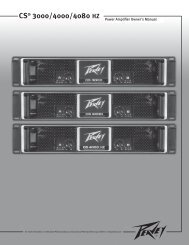Electric Guitar - Peavey
Electric Guitar - Peavey
Electric Guitar - Peavey
You also want an ePaper? Increase the reach of your titles
YUMPU automatically turns print PDFs into web optimized ePapers that Google loves.
<strong>Electric</strong> <strong>Guitar</strong>Owner's Manual
678<strong>Guitar</strong>Configuration591011121351542311. Pickup Height Screw2. 3-Way Pickup Selector3. Volume4. Tone Controls5. Strap Button6. Bridge7. Bridge Pickup8. Neck Pickup9. Position Markers10. Fret11. Fingerboard12. Nut13. Tuning Keys3
CongratulationsSo, you are the owner of a new <strong>Peavey</strong> <strong>Electric</strong> <strong>Guitar</strong>. Congratulations! Your purchaseproves your taste in musical instruments is superb. <strong>Peavey</strong> offers a wide variety ofguitars for beginners to professionals, each with unique qualities and features. Whileour professional luthiers have carefully inspected your guitar, every model requiressome initial set up, and periodic maintenance is required for peak performance.To ensure proper care of your quality instrument, visit www.peavey.com/accessoriesfor <strong>Peavey</strong>-recommended accessories, parts and cleaning supplies.4
When properly cared for, your <strong>Peavey</strong> guitar will offer you years of pleasure.Playing your guitar means that you will need to perform regular, generalmaintenance, such as cleaning and proper storage, to keep it looking andsounding great.Cleaning & CareEvery time you play your guitar, body oils and perspiration are transferred to thebody, back of the neck, headstock, fingerboards, strings, tuners, pickups andbridge. After you finish performing, but before you put your guitar away, take amoment to remove these contaminants.5
Cleaning - WoodTo clean and care for the major wood parts of your guitar (body, headstock or the back of the neck),<strong>Peavey</strong> recommends that you use a clean, soft, lint-free, dry cotton or <strong>Peavey</strong> micro-fiber cloth andspecially formulated HP's Axe Wax available at www.peavey.com/accessories. Use of an inappropriaterag or polish may result in scratching the finish of your instrument.WARNING: <strong>Peavey</strong> recommends that you do not use abrasives or solvents on your instrument.
Cleaning - FingerboardProperly caring for your fingerboard requires special attention. Over time, a fingerboard may lose itsnatural oils and shrink or exhibit a worn or faded appearance. <strong>Peavey</strong> recommends that you periodicallyapply a small amount of Lemon Oil (available at www.peavey.com/accessories) to your fingerboard(after removing strings) using a clean, soft, lint-free, dry cotton cloth, taking care to remove excess oilimmediately. A little goes a long way! How do you know when it is time to reapply? You can watch for achange in the appearance of your wood, or set a routine calendar date. However, do not allow too muchtime to pass as permanent damage may occur. If you allow the wood on the fingerboard to dry out andshrink, the frets will “stand out” and feel rough to the touch.7
Cleaning - MetalTo clean and lubricate the major metal partsof your guitar (strings, pickups, bridge,tuners), <strong>Peavey</strong> recommends that you use adifferent clean, soft, lint-free, dry cotton clothand specially formulated guitar string cleaneravailable at www.peavey.com/accessories.Forming a cloth fold and running it up and downthe length of each string can quickly clean strings.Failure to routinely clean and lubricate the metalparts of your instrument, including strings, mayresult in rusting.WARNING: <strong>Peavey</strong> recommends that you do not useabrasives or solvents on your instrument8
Your guitar is a piece of art that must be protected.When you are traveling with your instrument, loosenthe tuning knobs a turn or two to take pressure offthe neck, and protect it with a gig bag or case. Whilea gig bag offers some protection, mainly from dust,a hardshell case offers the best protection. If youplan to store your guitar for a long period of time,remember to slightly loosen your strings torelieve pressure on the neck. As with any pieceof art, don’t throw it in your trunk and leaveit in -10° or 110° weather! Always keep youguitar stored at room temperature, andavoid extreme changes in temperatureor humidity.Storage & Travel
AccessoriesAdd-on products like stands, hangers and straps that are made of plastic,rubber or man-made materials may chemically or physically react with anddamage the finish of your <strong>Peavey</strong> guitar. <strong>Peavey</strong> offers a full line of accessoriesat www.peavey.com/accessories).Every player needs a strap for peak performance, however, straps and strap buttonsare designed for “ordinary” use. If you anticipate “above ordinary” use, <strong>Peavey</strong>recommends that you use Super Strap Locks to secure your strap to your guitar(See <strong>Peavey</strong> accessories www.peavey.com/accessories).REMEMBER: <strong>Peavey</strong> Care Kits offer the best value for your money.Visit www.peavey.com/accessories, locate the order form inthe back of this manual, or call 866-443-2333 to placeyour order.10
StringsOld strings produce dull, buzzing or dead notes, while anew set of strings ring clear and true. If you play often,you will need to change your strings often. A good rule ofthumb is that if you play daily, you should change stringsevery two or three weeks. Replace your strings as you noticethem becoming dirty or discolored, before you experience adisappointing loss of performance.See page 12 for detailed instructions on changing strings.11
Changing Your StringsUnless you are reconditioning your fretboard (see care andcleaning), strings should be changed one at a time to maintainproper neck tension. New strings should be free of defects(twists, kinks, bends) that can cause sound irregularities orbreakage. All strings must be stretched upon installation.After your first tuning, carefully pull each string away from thefretboard, stretching it gently (too much force will break thinnerstrings). Then, retune your guitar.<strong>Peavey</strong> recommends that you replace strings in the samegauges to maintain proper neck and/or tremolo tension. Ifyou wish to change strings with different gauges, <strong>Peavey</strong>recommends that you enlist the services of a qualifiedtechnician to make the required truss rod and/or tremoloadjustments on your instrument.Some <strong>Peavey</strong> guitars feature ACM ® (page 13) or double-lockingtremolos (page 15).Standard Tuning(6th string is the heavey topmost string)Open note E A D G B EString 6 5 4 3 2 1Mnemonic memory aid for string tuning(Beginning with the 6th string):Eddie Ate Dynamite. Good Bye Eddie.Quick TipsTo change intonation, adjust saddles.To align tremolo in relation to thebody, adjust spring tension.To change string action (height),adjust tremolo studs.12
Changing strings on a <strong>Peavey</strong> guitar featuring an ACM Bridge is a simple task that will bring new life toyour instrument.Tools Needed:Wire cuttersElectronic tuner or pitch pipe (optional)ACM ® Bridge - Changing Your StringsNote: <strong>Peavey</strong> recommends changing one string at a time to maintain proper tension on the neck andbridge. Replace strings with the same gauges or you will need to make truss rod, spring tension, andintonation adjustments as described in this manual.First, detune the 6th string (the thickest, top string) using the machine head tuner—two or three turnsshould remove the tension on the string. Remove the string from the tuning peg; at the other end of thestring, push the string back through the string saddle until the ball end of the string comes out the holein the back of the guitar. (You may wish to cut off the portion of the string previously wound around thetuning peg to make this task easier.)13
ACM ® Bridge - Changing Your StringsInsert a new string through the hole in the back of the guitar and pull through until the ball end of thestring rests tightly against the underside of the bridge.Thread the other string end across the string saddle, across the nut and into the small hole in the correspondingmachine head tuning post. Allow two inches of slack for turning around the machine headpost. Each winding should be beneath the one before it to prevent slippage. Keep a light pressure on thestring with the fingers of your other hand while tightening using the tuners. (An inexpensive, optionalpeg winder makes winding much easier.) Cut off the excess string using wire cutters. Tune to pitch. Becausenew strings are prone to stretch when first installed, you should gently stretch the string by pullingit away from the neck and retune again.Repeat this procedure for the remaining strings, 5-1, remembering to tune each to pitch before proceedingto the next string. Retune each string until strings hold their relative pitch to one another.14
Double Locking Tremolo - Changing Your StringsThe <strong>Peavey</strong> double-locking tremolo system allows for pushing and pulling because the tremolo doesnot rest on the instrument body. Instead, it uses powerful springs, which are attached in the back ofthe body, to balance the tension created by the strings so that the tremolo “floats” within the enlargedcavity. While it is one the most reliable and popular tremolo systems in the world, to novice players,or even to the uninitiated seasoned player, changing strings the first time or two may seem like aoverwhelming task. Follow these simple steps and you’ll soon be able to change strings as easily asplaying your favorite licks.Tools Needed:3 mm Allen wrenchWire cuttersElectronic tuner or pitch pipeNote: <strong>Peavey</strong> recommends changing one string at a time to maintain proper tension on the neck andtremolo. Replace strings with the same gauges or you will need to make truss rod, spring tension andintonation adjustments as described in this manual.15
Double Locking Tremolo - Changing Your StringsFirst, detune the 6th string (the thickest, top string) using the machine head tuner—two or three turnsshould remove the tension on the string. Then, using a 3mm Allen wrench, unlock the correspondingstring clamp located at the nut. Then, back on the bridge, reset each Fine Tuner to its middle range.Now, you are ready to remove the 6th string.Using a 3mm Allen wrench, unclamp the 6th string at the saddle by loosening the saddle lockscrews at the rear of the tremolo. Remove string by sliding it out of the nut and unwrapping from thetuning machine head. Note: Broken string pieces can be removed easily with tweezers or a magneticscrewdriver.Using wire cutters, remove the ball end and extra wrapping of thereplacement string. (New strings should be free of twists, kinks andbends that can cause sound irregularities or breakage.) Insert the freshlycut end of the string into the saddle; tighten the saddle lock screws atthe rear of the tremolo until snug (View 1). TIP: For easier access to thetremolo screws, and to protect the finish of your guitar, tilt the rear of thetremolo upward using an attached tremolo arm (whammy bar). Do notovertighten the screws or you may permanently damage the saddles orstrip the Allen sockets.16View 1: Use allen wrench to secure string
Double Locking Tremolo - Changing Your StringsThread the other string end under the nut and into the small hole in thecorresponding machine head tuning post. Allow two inches of slack forturning around the machine head post (View 2).For the thicker strings (E, A, D), wrap the string end clockwise aroundpost, then run under string at post entry, and pull string tightly overitself, creating a knot. Strings G, B and E should be wound and securedin the same manner (counterclockwise on a three-a-side headstock, asin View 2). To avoid slippage, wind strings tightly from top to bottom onView 2: Insert string in machine head.each post, completing 2-3 wraps around each post. Keep a light pressureon the string with the fingers of your other hand while tightening the tuners. (An inexpensive, optionalpeg winder makes winding much easier.) Tune strings to correct pitch, checking post wraps for smoothwinding. String ends can then be bent down and trimmed near the knot.Because new strings are prone to stretch when first installed, you should gently stretch the string bypulling it away from the neck and retune again.17
Tune-O-Matic /Stop Tailpiece - Changing Your StringsTo replace strings, thread the new strings through the string holes located on the back of the tailpieceand bring them up and over the saddle. The intonation can be adjusted by moving the saddle forward orbackward using a Phillips head screwdriver on the adjustment screw at the rear of the bridge. Raise orlower the two height adjustment spinners on either side of the bridge to adjust string height.The height adjustment of the bar tailpiece can be raised or lowered by using the two height adjustmentstuds on either side of the tailpiece.18
Tuning Machine AdjustmentsOver time, tuners can become loose. Get in the habit of checking the tension with every string change.If you notice a change in the tension of a tuner, use a small flathead or Phillips screwdriver to tighten it(turn clockwise) or loosen it (turn counterclockwise) accordingly. Warning: While the screw should besnug, do not overtighten, as you may strip the screw.19
String ActionString action refers to the distance between thestrings and the frets on a stringed instrument. <strong>Peavey</strong>technicians carefully set optimal string action on everyguitar before it leaves our factory; however, changes intemperature and moisture (humidity), changing stringgauges, making neck adjustments or tuning can alterstring action enough to require a height adjustment torestore your guitar to factory specifications. Undesirablelow action causes buzzing, while abnormally high actionmakes your guitar difficult to play.
Pickup AdjustmentsFactory settings place pickups at the same volume level;however many players change the height of one or more neckor bridge pickups to create their own output levels. Shouldyou choose to alter the height of a pickup, remember that it ismagnetic. To keep your factory warranty intact, <strong>Peavey</strong> suggestsyou take your guitar to an Authorized <strong>Peavey</strong> Service Center tohave the pickup adjustments made.21
IntonationA properly intoned guitar will sound in tune no matter where you play along the fretboard.Intonation is determined by the length of each string as controlled by the location of eachstring’s saddle. To check intonation, complete all adjustments to the truss rod and stringaction, and tune your guitar. Then, compare the fretted sound of the 12th fret to the openharmonic of the 12th fret. (Harmonics are created by lightly placing a finger against astring—in this case, at the 12th fret—and striking normally with your picking hand. You’vedone it correctly if you hear a clear, loud, bell-like tone.) If the notes are the same, noadjustment is required. If they do not match, you will need to fine-tune each offendingstring using the adjustment screws to move the saddle location. If the fretted 12thnote is flat, adjust the saddle toward the neck. If sharp, move it away from the neck.Note that on some guitars, you will need to loosen strings before making saddleadjustments. Repeat the process until the fretted sound of the 12th fret matches theopen harmonic of the 12th fret.22
Neck and Truss RodEvery <strong>Peavey</strong> steel-string guitar features an adjustable truss rod inside the neck. Trussrods allow for adjustments in the neck to accommodate changes in string tensioncaused by humidity, changing string gauges or tuning. As the backbone of yourinstrument, the truss rod should always be adjusted first during instrument setup.(<strong>Peavey</strong> recommends that you enlist the services of a qualified technician to makethe required truss rod and/or tremolo adjustments on your instrument. Improperadjustment may damage your neck and void your <strong>Peavey</strong> warranty.) To gain accessto the truss rod, look for a 4 mm or 8 mm allen wrench adjustment screw either atthe end of the neck near the body or at the opposite end near the headstock. Notethat some guitars may require neck removal to gain access to the neck pocket trussrod. The goal of truss rod adjustment is to create the correct amount of bow in yourguitar’s neck to facilitate optimal playability.To check the neck’s bow, hold the guitar in normal playing position and followthis procedure for both E strings (string 1 and string 6). Fret and hold the string atthe first fret, while fretting and holding the same string with your picking- hand23
Neck and Truss Rodthumb (where the neck and body meet, typically around the 16th fret). Then, stretch your picking handindex finger as far as you can to fret the middle area of the neck, somewhere around fret 7-8-9. Thedistance your string travels to meet the fret is the bow. <strong>Peavey</strong> recommends a .3 mm to .5 mm (.010”to .020”) bow, easily measured and set with a steel rule. Too much bow leads to buzzing in the middleof the neck because the strings are too far away from the frets, while too little bow (backbow) causesexcessive buzzing on open notes and notes near the nut.To make adjustments for neck bow or relief (backbow), adjust the truss rod in 1/4 turn increments,and then recheck. If your neck is backbowed, loosen the truss rod by turning it counterclockwise. If ithas too much bow, tighten the truss rod by turning clockwise. Remember, a little truss rod adjustmentmakes a big change in how your guitar plays. Improper adjustment may damage your neck and voidyour <strong>Peavey</strong> warranty.24
This control determines the master output level of your instrument. Rotating the knob clockwise increasesvolume. Turning the knob counterclockwise decreases the volume. Some guitars feature multiplevolume controls, one assigned to each pickup. When the three-way pickup selector switch is set to themiddle position and one of the volume controls is set to OFF, the instrument will be off.The tone control determines the presence of high frequencies in your outgoing signal. All frequencies arepresent when the knob is fully clockwise, and the highs diminish as the knob is turned counterclockwise.WARNING: To prevent voiding your factory warranty, <strong>Peavey</strong> suggestsall adjustments be made at an Authorized <strong>Peavey</strong> Service Center.Volume and Tone Control25
Pickups & Pickup Selector SwitchSingle-coil pickups and dual-coil pickups(humbuckers) convert your guitar’s string vibrationsinto an electronic signal that is processed by youramplifier.Selector switches are used to quickly changebetween pickups or combinations of pickups.Typically switches are 3-way slotted, 5-way slottedor 3-way toggled. Series selections, typicallyfound on humbucker models, combine two coils offull output. Parallel selections combine two coilsto simulate a single coil while acting as a humcancelinghumbucker. Some guitars feature a pushpullvolume control in place of a switch that allowsfor single pickup selections.26
Balance Control & Push-Pull or Push-Push Coil TapTo create a specific tone, some instruments feature a balance control that determines the mix of pickupsignals being sent to the amplifier. In the center (detented) position, both pickups send the samevolume. Turning the knob counterclockwise selects more bridge pickup signal, while turning it clockwisesends more neck pickup signal.When engaged, this switch, usually located on a Volume Control or Tone Control, allows one coil froma dual pickup to be turned off, effectively cutting the output in half. Note that as the humbucker is nowfunctioning as a single coil, it will exhibit more hum or noise.27
Accessories<strong>Peavey</strong> offers a wide range of accessory products to support and enhance your purchase. Please visitthe <strong>Peavey</strong> web site, www.peavey.com for specific details and suggested list prices.Item Number Description00081340 10’ Black Instrument Cable00082930 15’ Black Instrument Cable00081360 20’ Black Instrument Cable00351210 25’ Black Instrument Cable00493970 10’ Silent Instrument Cable00493980 15’ Silent Instrument Cable00493990 20’ Silent Instrument Cable00478950 Hardshell <strong>Guitar</strong> Case00722780 Nylon <strong>Guitar</strong> Bag00479950 <strong>Electric</strong> <strong>Guitar</strong> Bag00444820 <strong>Electric</strong> Lite CaseItem Number Description00577920 Balanced 8s Nickel Wound Elements<strong>Electric</strong> <strong>Guitar</strong> Strings00579450 Balanced 9s Nickel Wound Elements<strong>Electric</strong> <strong>Guitar</strong> Strings00579460 Balanced Plus 9s Nickel WoundElements <strong>Electric</strong> <strong>Guitar</strong> Strings00579470 Balanced 10s Nickel Wound Elements<strong>Electric</strong> <strong>Guitar</strong> Strings00577930 Balanced 11s Nickel Wound Elements<strong>Electric</strong> <strong>Guitar</strong> Strings00577940 Balanced 12s Nickel Wound Element<strong>Electric</strong> <strong>Guitar</strong> Strings03009010 PT-100 CHROMATIC TUNER/Recorder28
AccessoriesItem Number Description00479470 Thin Dreamers Red 351, 12-pieceguitar pick set00479480 Thin/Medium Dreamers Orange 351, 12-piece guitar pick set00479490 Medium Dreamers Yellow 351, 12-pieceguitar pick set00479500 Medium/Heavy Dreamers Green 351, 12-piece guitar pick setItem Number Description00479510 Heavy Dreamers Blue 351, 12-pieceguitar pick set00479520 Extra Heavy Dreamers Purple 351, 12-piece guitar pick set00089200 <strong>Peavey</strong> Black Padded Strap00592510 <strong>Electric</strong> <strong>Guitar</strong> Accessory Pack
WarrantyYour <strong>Peavey</strong> Warranty covers defects in material and workmanship in <strong>Peavey</strong> products purchased and serviced in the U.S.A. and Canada.What This Warranty Does Not CoverThe Warranty does not cover: (1) damage caused by accident, misuse, abuse, improper installation or operation, rental, product modificationor neglect; (2) damage occurring during shipment; (3) damage caused by repair or service performed by persons not authorizedby <strong>Peavey</strong>; (4) products on which the serial number has been altered, defaced or removed; (5) products not purchased from an Authorized<strong>Peavey</strong> Dealer.Who This Warranty ProtectsThis Warranty protects only the original purchaser of the product.How Long This Warranty LastsThe Warranty begins on the date of purchase by the original retail purchaser. The duration of the Warranty for guitars is 2 years *(+ 3years). [* denotes additional warranty period applicable if optional Warranty Registration Card is completed and returned to <strong>Peavey</strong> byoriginal retail purchaser within 90 days of purchase.]What <strong>Peavey</strong> Will DoWe will repair or replace (at <strong>Peavey</strong>'s discretion) products covered by warranty at no charge for labor or materials. If the product orcomponent must be shipped to <strong>Peavey</strong> for warranty service, the consumer must pay initial shipping charges. If the repairs are covered bywarranty, <strong>Peavey</strong> will pay the return shipping charges.How To Get Warranty Service(1) Take the defective item and your sales receipt or other proof of date of purchase to your Authorized <strong>Peavey</strong> Dealer or Authorized30
<strong>Peavey</strong> Service Center.OR(2) Ship the defective item, prepaid, to <strong>Peavey</strong> Electronics Corporation, International Service Center, 412 Highway 11 & 80 East, Meridian,MS 39301. Include a detailed description of the problem, together with a copy of your sales receipt or other proof of date of purchase asevidence of warranty coverage. Also provide a complete return address.Limitation of Implied WarrantiesANY IMPLIED WARRANTIES, INCLUDING WARRANTIES OF MERCHANTABILITY AND FITNESS FOR A PARTICULAR PURPOSE, ARE LIMITEDIN DURATION TO THE LENGTH OF THIS WARRANTY.Some states do not allow limitations on how long an implied warranty lasts, so the above limitation may not apply to you.Exclusions of DamagesPEAVEY'S LIABILITY FOR ANY DEFECTIVE PRODUCT IS LIMITED TO THE REPAIR OR REPLACEMENT OF THE PRODUCT, AT PEAVEY'S OP-TION. IF WE ELECT TO REPLACE THE PRODUCT, THE REPLACEMENT MAY BE A RECONDITIONED UNIT. PEAVEY SHALL NOT BE LIABLE FORDAMAGES BASED ON INCONVENIENCE, LOSS OF USE, LOST PROFITS, LOST SAVINGS, DAMAGE TO ANY OTHER EQUIPMENT OR OTHERITEMS AT THE SITE OF USE, OR ANY OTHER DAMAGES WHETHER INCIDENTAL, CONSEQUENTIAL OR OTHERWISE, EVEN IF PEAVEY HASBEEN ADVISED OF THE POSSIBILITY OF SUCH DAMAGES.Some states do not allow the exclusion or limitation of incidental or consequential damages, so the above limitation may not apply toyou.This Warranty gives you specific legal rights, and you may also have other rights which vary from state to state.If you have any questions about this warranty or services received or if you need assistance in locating an Authorized Service Center,please contact the <strong>Peavey</strong> International Service Center at 877-732-8391(toll-free) or customerservice@peavey.com. Features andspecifications subject to change without notice.31Warranty
Features and specifications subject to change without notice.<strong>Peavey</strong> Electronics Corporation • 5022 Hartley <strong>Peavey</strong> Dr • Meridian, MS 39305(601) 483-5365 • FAX (601) 486-1278 • www.peavey.com© 2006 Printed in the U.S.A 80307338


